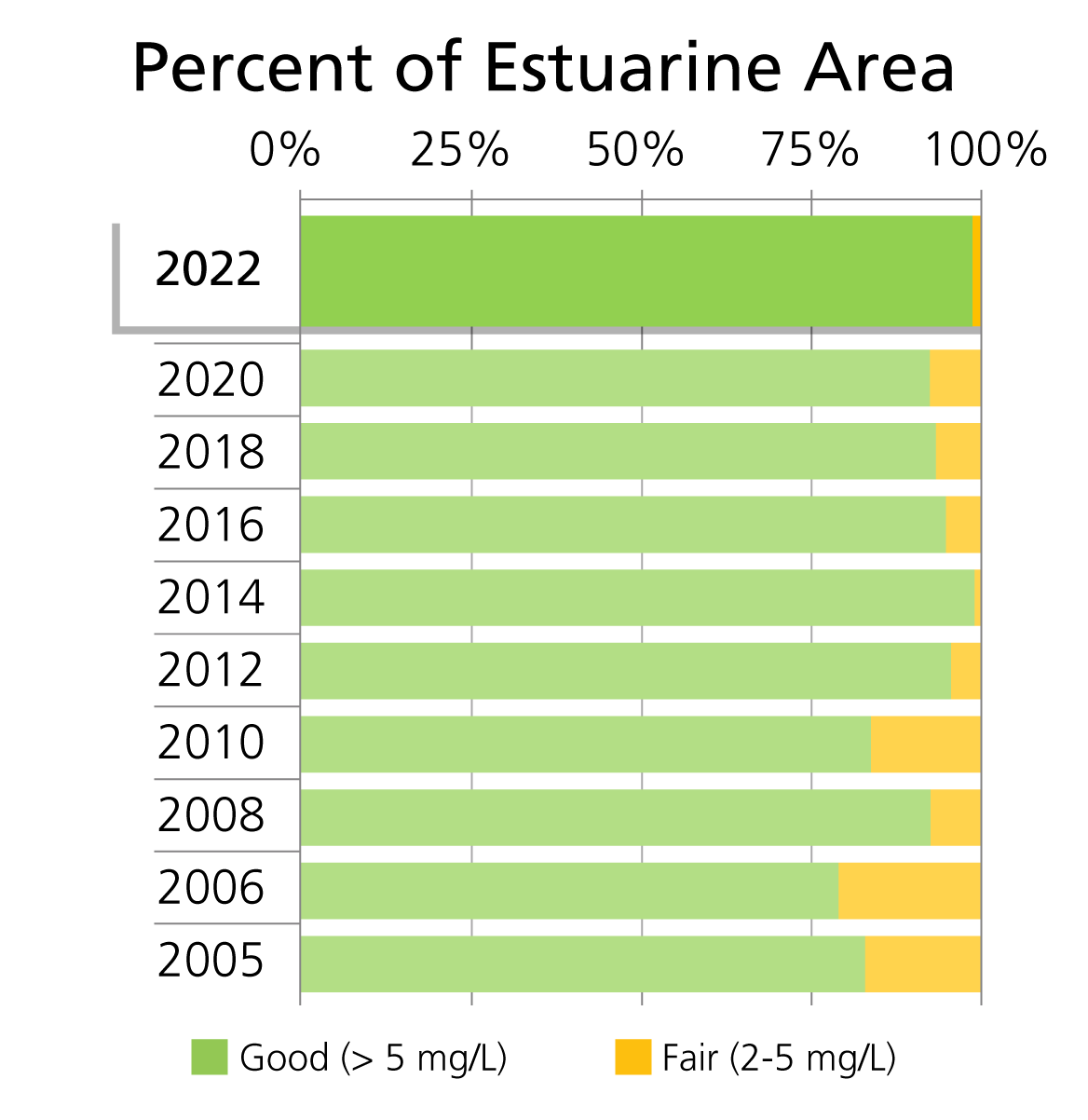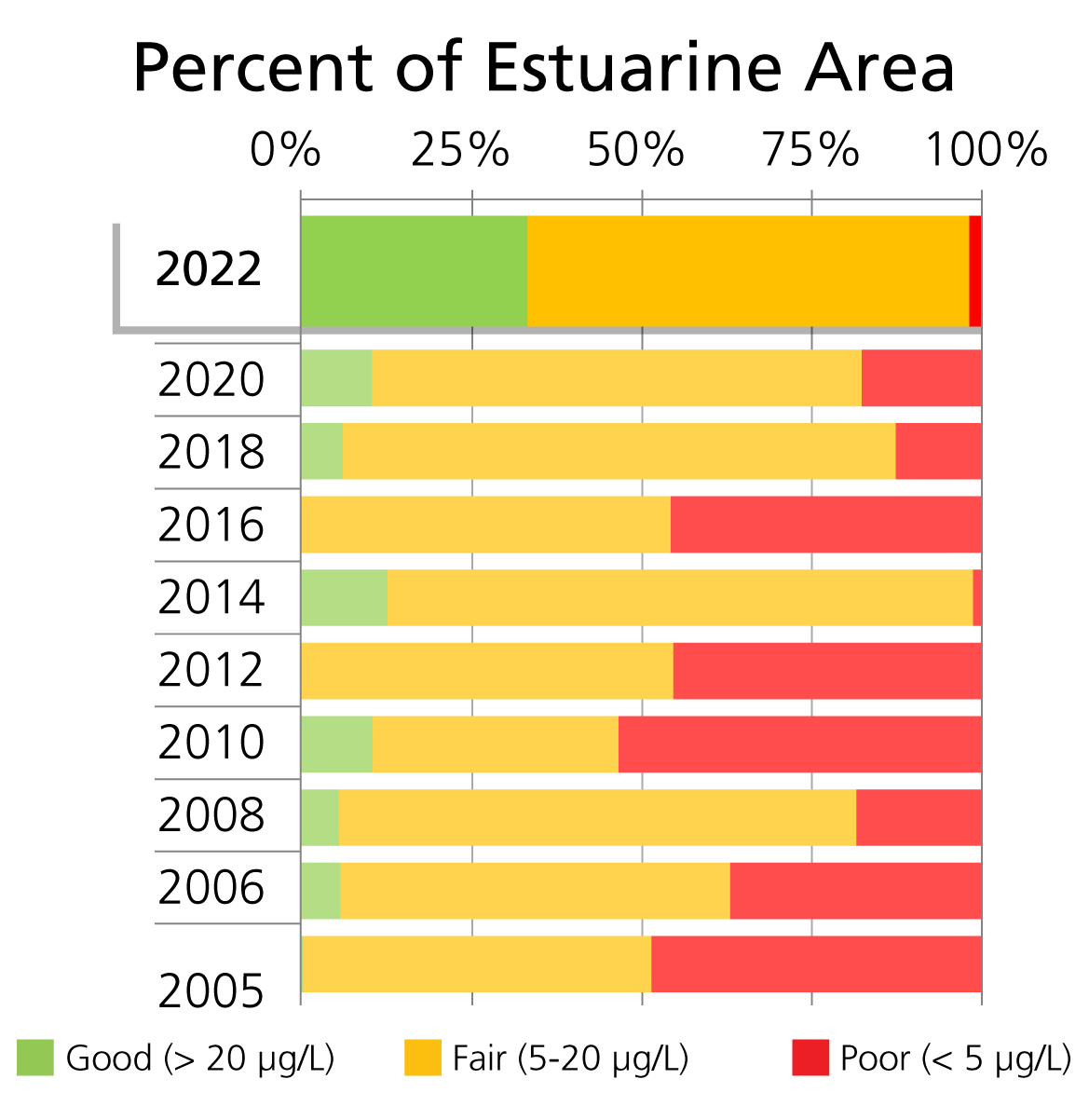Part of a series of articles titled NCBN Yearly Status Reports | Estuaries.
Article • NCBN Yearly Status Reports | Estuaries
2022 Estuarine Nutrient Enrichment Status Report: Assateague Island NS

Site Context
Assateague Island National Seashore (ASIS) is a 60km long barrier island off the eastern coast of the Delmarva Peninsula, extending into the Atlantic Ocean (Fig. 1). The northern two-thirds of the island is in Maryland, while the southern third is in Virginia. ASIS one of two NER coastal parks with a highly developed water-quality monitoring program, through a joint effort among many federal and state partners. The park boundary encircles the NPS holdings, the U.S. Fish and Wildlife Service’s Chincoteague National Wildlife Refuge, and Maryland’s Assateague State Park. Further, Sinepuxent Bay and the MD portion of Chincoteague Bay are managed under the Maryland Coastal Bays Program as a National Estuary Program estuary. Consequently, the park has monitoring interests throughout the coastal bay, and is not confined in its interests to the area within the park boundary. Approximately 37,319 ha of estuary is monitored for this protocol. About 6,867 ha of that area falls inside park boundaries, representing 100% of NPS estuarine resources within ASIS.
The threat of nutrient enrichment is a primary management concern. Water quality monitoring follows Northeast Coastal and Barrier Network’s Protocol for Monitoring Estuarine Nutrient Enrichment (Kopp and Neckles, 2009). The protocol’s primary goal is to assess how estuarine natural resources are affected by changing nutrient inputs by determining the status and trends of response indicators within the monitored estuarine areas of each park.
Presented here are condition status summaries of three key response indicators:
1) bottom water dissolved oxygen (DO)
2) surface water chlorophyll-a
3) water column light attenuation (Kd)
Threshold values are used to determine “good”, “fair”, and “poor” condition categories (Table 1), which are consistent with those used by the US Environmental Protection Agency (USEPA) for national coastal condition reporting (USEPA 2001b, 2004) and thresholds used by National Oceanic and Atmospheric Association for the National Estuarine Eutrophication Assessment (Bricker et al. 1999).
Water clarity is expressed as Kd (m-1). Cutoff values of Kd have been calculated from the USEPA criteria for turbidity, using the thresholds for areas with significant submerged aquatic vegetation (SAV).
| Measure | Good | Fair | Poor |
|---|---|---|---|
| Chlorophyll-a | < 5 µg/L | 5-20 µg/L | > 20 µg/L |
| Dissolved oxygen | > 5 mg/L | 2-5 mg/L | < 2 mg/L |
| Light attenuation | < 0.92 m-1 | 0.92-1.61 m-1 | > 1.61 m-1 |
Bottom Water Dissolved Oxygen
Bottom water DO concentration is an indirect indicator of nutrient load and direct indicator of estuarine water chemistry and organism health. Oxygen is consumed when microbial decomposers mineralize organic matter on and within estuarine sediments. When sediment organic matter increases due to nutrient over-enrichment it can cause an overgrowth of nuisance algae. The resulting heightened microbial decomposition can lower DO concentrations in bottom waters. It can also lead to increased extent and duration of bottom water anoxia and toxic sulfide concentrations. Nutrient enrichment can, ultimately, impact fauna diversity and abundance and shift species dominance.
During the 2022 summer index period, ASIS park-wide average near bottom water dissolved oxygen (DO) concentration was good within 98.8% of the sampled estuarine area, and poor within 1.2% (Fig. 2). 2022 conditions were consistent with previous index periods. Since the study began, bottom water DO concentrations have been observed as good in a majority of the ASIS sampled area.
Surface Water Chlorophyll-a
Nutrient enrichment often stimulates phytoplankton production, leading to population growth. Phytoplankton growth is often nutrient-limited. Trends of increasing biomass can suggest increasing nutrient load. Surface water chlorophyll-a concentration is an indicator of phytoplankton population growth, nutrient enrichment, and overall water quality.

Water Column Light Attenuation
Submerged aquatic vegetation (SAV) provide important ecosystem services. SAV productivity and distribution depend on light. Light attenuation through the water column is dependent on concentrations of phytoplankton, which can correlate with nutrient enrichment, and suspended inorganic and dissolved organic matter. Regardless of current SAV presence, NCBN continues to monitor this critical SAV parameter, as it provides information relevant to the overall estuarine eutrophication status.
Conclusion
In 2022, Assateague Island National Seashore saw varying conditions of bottom water dissolved oxygen, surface water chlorophyll-a, and water column light attenuation (Kd).The majority of estuarine area sampled for bottom water dissolved oxygen concentration was in good condition. Historically, bottom water dissolved oxygen levels have been good for most of the estuary. In terms of surface water chlorophyll-a, the majority of the estuary was in fair condition. ASIS has seen similar surface water chlorophyll-a conditions in previous index periods. Water column light attenuation was improved compared to previous years, with a greater percentage in fair and good condition, breaking the trend of a majority poor water clarity condition between 2005 and 2020.Conditions of surface water chlorophyll-a and water column light attenuation at Assateague National Seashore in 2022 indicate that the estuarine system remains nutrient over-enriched.

NPS Photo / Michaela Compo
References
Kopp, B. S. and H.A. Neckles. 2009. A Protocol for Monitoring Estuarine Nutrient Enrichment in Coastal Parks of the National Park Service Northeast Region. Natural Resource Report NPS/NCBN/NRR—2009/110. National Park Service, Fort Collins, Colorado.
U.S. EPA. 2001. National coastal assessment: field operations manual. U.S. Environmental Protection Agency, Office of Research and Development, National Health and Environmental Effects Research Laboratory, Gulf Ecology Division, Gulf Breeze, FL. EPA 620/R-01/003.
U.S. EPA: 2003. Ambient Water Quality Criteria for Dissolved Oxygen, Water Clarity and Chlorophyll a for the Chesapeake Bay and Its Tidal Tributaries, EPA-903/R-03/002, United States Environmental Protection Agency, Region III Chesapeake Bay Program Office, Annapolis, MD; Region III Water Protection Div., Philadelphia, PA, and Office Water, Office of Science and Technology, Washington, D.C.
Last updated: September 25, 2024






